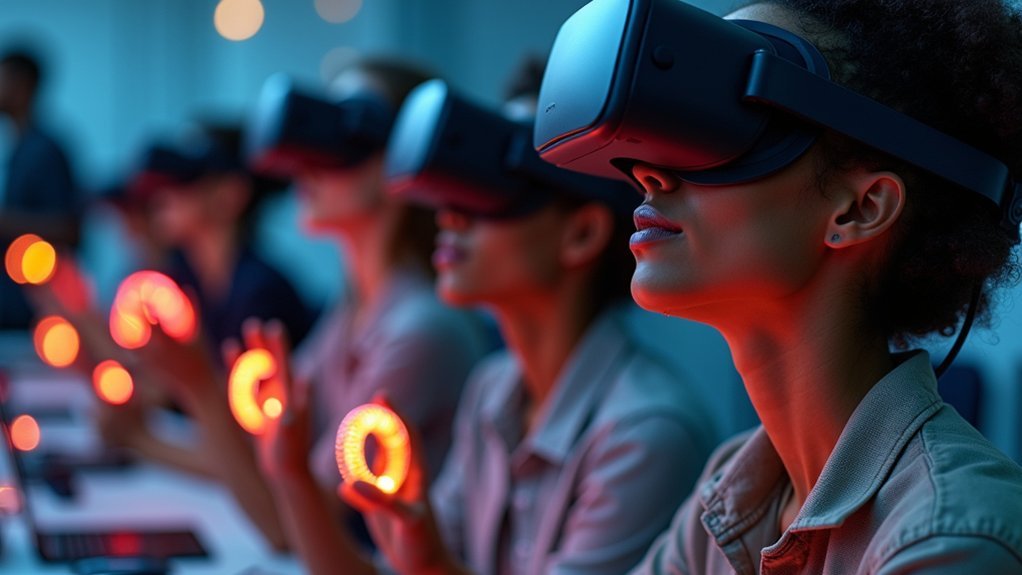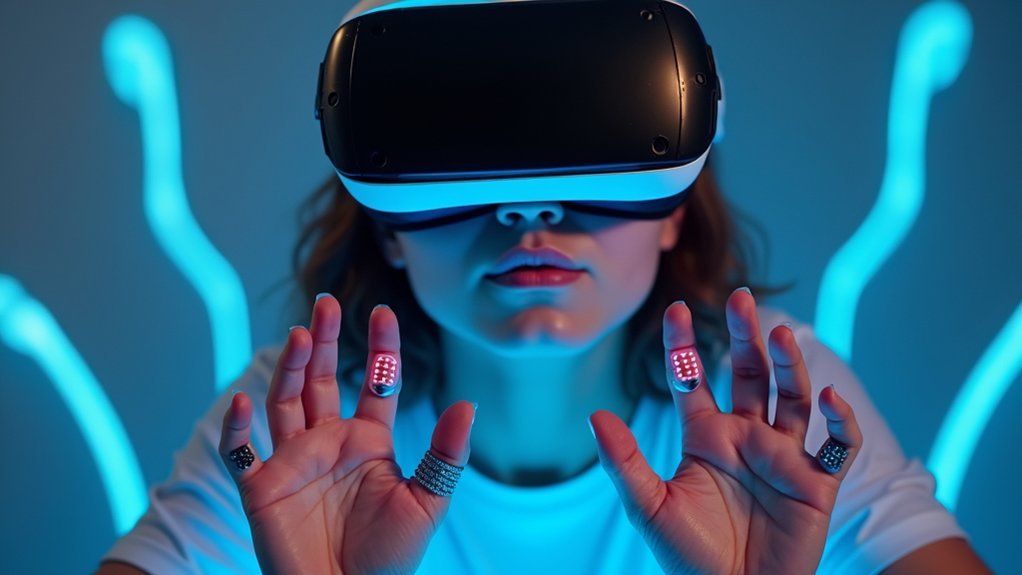Haptic feedback technology transforms your VR experience by adding tactile sensations through specialized gloves, vests, and controllers that deliver vibrations, resistance, and pressure feedback. You’ll navigate virtual environments through touch-based design that translates spatial information into haptic signals, making VR accessible for users with visual impairments or other sensory needs. Customizable intensity settings adapt to your specific requirements, while voice commands integrate seamlessly with tactile responses. Discover how these innovations create truly inclusive digital experiences.
Understanding Haptic Feedback Technology in Virtual Reality

Touch transforms how you experience virtual reality, bridging the gap between digital imagination and physical sensation. Haptic feedback technology revolutionizes virtual reality by delivering tactile sensations through specialized devices like gloves and vests.
These innovations create immersive experiences that vibrate, resist, and respond to your movements, making virtual objects feel extraordinarily real.
Advanced haptic technology creates tactile sensations that make virtual environments feel tangibly real through responsive feedback systems.
For users with disabilities, particularly those who are blind or visually impaired, haptic feedback becomes essential for accessibility. This technology transforms navigation within virtual environments, allowing you to feel textures, boundaries, and interactions that visual cues can’t provide.
Research demonstrates that incorporating tactile elements greatly improves your emotional connection to VR experiences while enhancing usability across rehabilitation and educational applications. This inclusive content approach guarantees virtual reality becomes truly accessible for diverse user needs.
Breaking Down Sensory Barriers Through Touch-Based VR Design
When traditional sensory channels fail to deliver complete information, touch-based VR design steps in to create meaningful pathways for interaction.
You’ll find that haptic devices transform virtual reality into an immersive experience that prioritizes accessibility for individuals with sensory impairments. These innovations don’t just add features—they fundamentally reshape how you navigate and understand digital spaces.
Touch-based design delivers essential benefits:
- Spatial orientation guidance through vibrations and pressure feedback that help you understand your position in virtual environments
- Customizable tactile experiences that adapt to your specific needs and comfort levels
- Enhanced emotional well-being through meaningful interactions that foster genuine connection and belonging
This inclusive design approach guarantees tactile feedback becomes your bridge to full participation in virtual worlds, regardless of visual or auditory limitations.
Tactile Navigation Systems for Visually Impaired Users

As you explore virtual environments without sight, specialized tactile navigation systems become your essential compass, translating spatial information into precise haptic signals that guide your movement and interaction.
These tactile navigation systems for visually impaired users employ sophisticated haptic feedback technology to create meaningful physical sensations. When you wear vibrating gloves, you’ll feel virtual objects and surfaces, enabling intuitive virtual navigation through digital spaces.
Advanced tactile interfaces integrate braille displays and tactile maps, delivering accessible environmental information directly to your fingertips. This innovation markedly enhances your immersion and engagement levels, creating meaningful connections with digital content.
Studies demonstrate that tactile feedback dramatically improves your VR experience, while ongoing technological developments continue advancing precision and responsiveness. These accessibility innovations guarantee virtual environments become truly inclusive spaces where you can navigate confidently and interact naturally through touch.
Haptic Controllers and Adaptive Input Devices
You’ll experience a new level of immersion when haptic controllers deliver precise tactile feedback that lets you feel virtual textures, shapes, and resistance as if they’re real.
These advanced systems become even more powerful when paired with adaptive input solutions designed specifically for your needs, whether you’re steering with one hand or require larger, more accessible button layouts.
The combination of sophisticated haptic technology and customized input devices transforms VR from a visual experience into something you can truly touch and manipulate.
Advanced Haptic Technology
While traditional VR controllers rely on visual and auditory cues, advanced haptic technology transforms how you experience virtual environments by adding the essential element of touch. This tactile feedback creates immersive interaction opportunities that revolutionize accessibility for users with visual impairments and varying sensory sensitivities.
Advanced haptic systems offer remarkable customization and navigation capabilities:
- Haptic gloves and vests deliver vibration and pressure sensations, letting you physically feel virtual objects and surfaces.
- Brain-computer interfaces interpret your neural signals, enabling interaction without physical movement requirements.
- Adaptive controllers provide personalized intensity levels and responses tailored to your specific accessibility needs.
These innovations greatly boost user engagement by making virtual experiences more realistic and inclusive, ensuring everyone can participate fully in VR environments regardless of their physical abilities.
Adaptive Input Solutions
Adaptive input solutions represent the next frontier in making VR experiences truly universal, breaking down barriers that traditional controllers can’t address. When you have visual impairments, adaptive input devices like eye-tracking technology and voice recognition systems let you navigate virtual environments hands-free, expanding accessibility options considerably.
These innovations create an inclusive digital landscape where mobility challenges don’t limit your participation.
You’ll find that haptic feedback enhances user engagement, especially if you’re dealing with sensory processing disorders or fine motor skill impairments. Customizable haptic gloves simulate various textures, allowing you to experience tactile interactions that mirror real-world sensations.
These solutions don’t just accommodate diverse needs—they transform how everyone experiences VR, making digital spaces more intuitive and immersive for all users.
Spatial Awareness Through Vibrotactile Feedback

As you move through virtual environments, vibrotactile feedback transforms how you perceive space by delivering precise tactile cues that correspond to objects and surfaces around you. This technology creates an immersive experience that enhances spatial awareness through haptic devices like gloves and vests, making interaction intuitive for all users.
Vibrotactile feedback particularly benefits users with visual impairments by:
Vibrotactile technology empowers visually impaired users through tactile navigation, depth perception, and spatial understanding in virtual environments.
- Simulating touch and vibrations to help navigate virtual spaces effectively
- Reinforcing concepts of depth and distance through tactile sensations
- Enabling precise object location and spatial relationship understanding
These tactile experiences foster inclusivity by ensuring users with disabilities can fully engage with virtual environments.
Research shows this technology greatly improves your ability to perceive spatial relationships, creating more intuitive interactions that benefit everyone while promoting accessibility.
Voice Command Integration With Tactile Response Systems
When you combine voice commands with haptic feedback in VR, you’re creating a powerful synergy that transforms how you navigate virtual spaces through coordinated audio and tactile cues.
You’ll discover that speaking directions while feeling corresponding vibrations or resistance creates an intuitive control system that responds to both your verbal input and physical movements.
This multi-modal approach gives you enhanced control precision, allowing you to execute complex VR interactions through natural speech while receiving immediate tactile confirmation of your actions.
Voice Navigation Haptic Synergy
Voice commands paired with haptic feedback revolutionize how you’ll interact with virtual environments, creating an intuitive bridge between spoken intent and tactile confirmation.
This voice navigation system transforms accessibility for users with mobility impairments, eliminating dependence on traditional controllers while delivering rich sensory feedback through tactile responses.
The synergy creates truly immersive experiences where your spoken words trigger immediate physical sensations, enhancing situational awareness and emotional connection to virtual worlds.
Key benefits include:
- Hands-free interaction – Navigate complex virtual environments using only voice commands
- Enhanced spatial awareness – Receive tactile confirmation of your location and available interactions
- Intuitive accessibility – Experience inclusive VR without requiring fine motor skills or traditional input methods
This innovative fusion makes virtual reality genuinely accessible to diverse users.
Multi-Modal Control Benefits
Beyond traditional single-input methods, multi-modal control systems reveal unprecedented levels of interaction by seamlessly blending voice commands with tactile response technologies.
You’ll experience enhanced immersion when voice command integration works alongside tactile feedback devices, creating intuitive interaction patterns that feel natural and responsive. These systems greatly boost accessibility by accommodating diverse accessibility needs, ensuring everyone can participate fully in virtual environments.
Your engagement levels increase dramatically when you’re not limited to single input methods. Multi-modal control systems enable richer social interactions and collaborative experiences, allowing you to connect with others regardless of your abilities.
Whether you’re maneuvering through complex virtual spaces or working together on shared projects, you’ll find these combined technologies create more inclusive and satisfying VR experiences for all users.
Customizable Haptic Settings for Diverse Accessibility Needs
As VR technology advances, customizable haptic settings emerge as an essential bridge between virtual experiences and users with diverse accessibility needs.
These personalized haptic feedback systems transform how you experience virtual worlds by adapting to your specific requirements.
Haptic feedback devices create inclusive environments through:
- Intensity adjustments – You can modify tactile strength based on your sensory sensitivity levels
- Navigation assistance – Users with visual impairments receive essential spatial cues through touch sensations
- Motor skill accommodation – Fine motor impairments don’t limit your interaction capabilities with adaptive controls
Adaptive haptic technology enhances immersion and interaction while fostering emotional connection within virtual spaces.
Customizable haptic feedback bridges the gap between virtual worlds and meaningful human connection through touch.
When accessibility for users becomes prioritized through these innovations, enhancing the overall experience isn’t just possible—it’s revolutionary for making VR truly inclusive for people across all abilities.
Real-World Applications of Tactile VR in Education and Training
These customizable haptic innovations find their most transformative expression in educational settings, where tactile VR reshapes how learners engage with complex subjects.
You’ll discover students manipulating virtual anatomical models in biology classes, gaining deeper understanding through physical interaction with three-dimensional structures. Healthcare training programs utilize tactile feedback to simulate patient interactions, developing empathetic caregiving skills that traditional methods can’t replicate.
In vocational environments, you’ll see enhanced skill acquisition and retention rates, with trainees reporting considerably higher engagement levels.
STEM subjects become more accessible when you can physically manipulate virtual environments, fostering inclusivity for students with diverse abilities.
These applications demonstrate how tactile VR transforms abstract concepts into tangible experiences, making complex educational content accessible through hands-on virtual exploration.
Medical Rehabilitation Using Haptic-Enhanced Virtual Environments
You’ll find that haptic-enhanced VR environments are transforming medical rehabilitation by creating immersive spaces where stroke survivors can safely practice movement and coordination.
These systems don’t just focus on physical recovery—they’re also proving effective for cognitive therapy, where patients can engage with virtual scenarios that challenge memory, attention, and problem-solving skills.
Your rehabilitation experience becomes more engaging and personalized when haptic feedback devices provide the tactile sensations that make virtual exercises feel realistic and meaningful.
Stroke Recovery Applications
When stroke survivors engage with haptic-enhanced virtual environments, they’re experiencing a revolutionary approach to rehabilitation that combines cutting-edge technology with proven therapeutic principles.
These stroke recovery applications deliver tactile feedback through haptic feedback devices like vibrating gloves, creating an immersive experience that simulates real-world sensations during rehabilitation exercises.
You’ll find these systems incorporate:
- Gamified elements that motivate repeated practice essential for neuroplasticity and muscle re-education
- Resistance simulation allowing you to feel virtual object textures and weight during motor function training
- Tele-rehabilitation capabilities connecting remote patients with specialized therapy programs
Research demonstrates remarkable results – you can achieve up to 20% improvement in upper limb function when combining VR with traditional therapy.
This enhanced engagement transforms repetitive exercises into interactive experiences, maximizing your recovery potential.
Cognitive Therapy Benefits
As cognitive rehabilitation evolves beyond traditional paper-and-pencil exercises, haptic-enhanced virtual environments are transforming how patients rebuild essential mental functions after neurological injury.
You’ll experience tactile feedback that makes rehabilitation exercises feel more engaging and realistic, greatly boosting your motivation and adherence to treatment protocols.
VR cognitive therapy creates safe environments where you can practice cognitive skills while receiving immediate haptic responses that enhance learning retention.
This approach particularly benefits your spatial awareness and motor skills development, especially when recovering from neurological conditions like stroke or traumatic brain injury.
Haptic technology enables personalized therapy that adapts to your specific responses, optimizing treatment effectiveness.
You’ll find yourself more present and connected during sessions, leading to measurably better rehabilitation outcomes.
Advancing Inclusive Design Standards for Future VR Development
While VR technology continues to evolve at breakneck speed, developers can’t afford to leave accessibility as an afterthought—inclusive design must become the foundation of future VR development.
Inclusive VR design isn’t optional—it’s the cornerstone of technology that truly serves everyone in our digital future.
By advancing inclusive design through user-centric approaches, you’re creating accessible VR experiences that serve users with diverse disabilities.
Essential standards are driving this transformation:
- Web Content Accessibility Guidelines and XRAUR provide thorough frameworks for accommodating visual, auditory, and mobility impairments
- Haptic feedback devices and customizable controllers enhance tactile interactions for users with sensory disabilities
- Collaborations between developers and accessibility experts establish principles ensuring virtual reality technology meets everyone’s needs
When you integrate feedback from users with disabilities, you’re not just improving accessibility—you’re boosting overall engagement and satisfaction while fostering a more equitable digital landscape.
Frequently Asked Questions
In What Ways Can AI Improve Accessibility and Inclusivity in Immersive Technologies Such as VR and AR?
You’ll benefit from AI-powered voice controls replacing physical interactions, personalized interfaces adapting to your needs, haptic feedback providing tactile experiences, real-time captioning for audio content, and predictive analytics identifying accessibility barriers before they affect you.
How to Make VR Accessible?
You can make VR accessible by implementing haptic feedback gloves, voice recognition controls, customizable one-handed navigation, real-time captioning features, and creating diverse content that represents different disability perspectives and experiences.
What Is One Way Virtual Reality Work Meeting Could Be More Inclusive?
You can implement real-time captioning and audio-to-text conversion in VR work meetings. This’ll enable participants who’re deaf or hard of hearing to fully engage in discussions and understand all spoken content.
What Makes VR Innovative?
You’ll experience cutting-edge haptic feedback that lets you feel virtual objects, while eye-tracking and brain-computer interfaces eliminate physical controllers. Voice recognition enables hands-free navigation, creating truly immersive, accessible experiences.





Leave a Reply